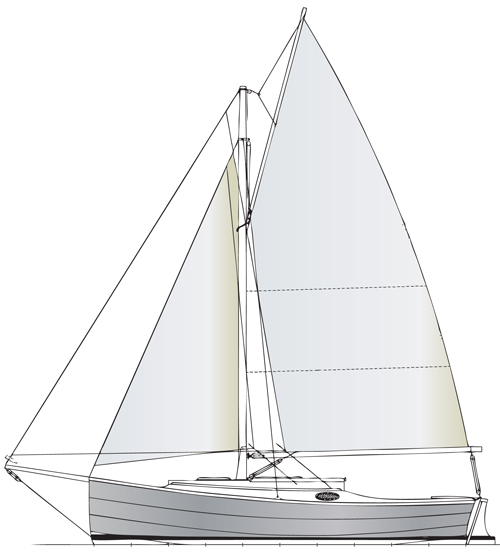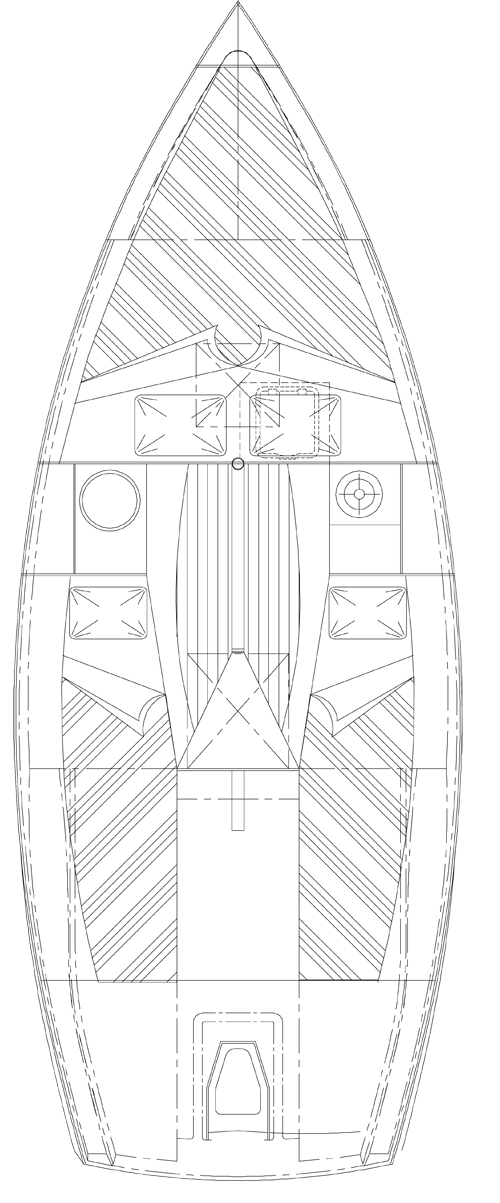Cape Henry 21 Pocket cruiser
I'm absolutely certain my dear old pal and critic Dr. Walter will love this design. It's perfect for him. The boat was designed by another old friend of mine, Dudley Dix, and is a variation on his 19-foot Cape Cutter. The Cape Cutter proved quite successful with 70 boats sold in its first two years, but there was a market for a bigger boat so Dudley drew up this 21-footer. It's a dandy looking boat with a strong sheer and beautiful proportions. You can build it in your garage from Dudley's detailed drawings or you can buy a kit and finish it yourself. Dudley's home-builder creations have a distinct advantage. Dudley can actually build the boat himself and has built several. He knows what to draw to make the home-build process easy and he can give advice and help along the way.

This hull is built with plywood lapstrake construction. The wide planks overlap each other and, done correctly, can really accentuate the beauty of the hull lines. But Dudley did not trust his computer program to get the interplay of hull shape and lapstrakes correct, so he dusted off his drawing board, hunted for a pencil and drew the hull lines by hand. Only when he was happy with his hand-drawn lines did he transfer the shape into the computer for AutoCAD finishing details. The boat can be built with a centerboard or bilge keels and draws 4 feet, 5 inches with the centerboard down. The fixed bilge keel version draws 2 feet, 4 inches. The nice thing about bilge keels is that if the tide goes out and leaves you sitting on the mud you can sit there with style and grace while other boats lie on their side and look a bit forlorn. The D/L is 184. The L/B is 2.4, so this is a fat little boat but still under the 8-foot wide trailering limit. I think if you were after performance I'd go with the centerboard model. It's a slick hull form and I think this boat will sail nicely.

The mast is hollow timber fabricated in the birdsmouth method. I have no idea what that is but I'm sure it works because a couple can raise this mast without any mechanical devices. It's drawn as a cutter but at 21 feet you sail the boat upwind with just the jib and main. You add the staysail for reaching or heavy air. The spreaders are swept 25 degrees so you don't need a backstay. The bowsprit hinges back to save room and moorage fees at the dock.
There's not much below and if you go with the centerboard model you will have that large centerboard trunk intruding into your living space. There's room for a porta potty, a single-burner Origo stove and a small sink. You'll be tight but stylish and the envy of every 60-footer you glide on by in the anchorage. The auxiliary is an outboard hidden away in a well just forward of the transom.
I love simple little boats. I have one. They make you become a sailor. They remove you from all the "conveniences" of life on shore. They reduce life to staying dry, staying rested and staying well fed from hearty one-pot meals. Your refrigeration won't break. Your sanitation system will not explode. Your battery bank will not suddenly go dead. And you can glide into the dock under sail, step off, grab the shroud and bring the boat to a halt with ease.
Nice work Dudley. This is a well-crafted design.
LOA 20'11"; LWL 19'10"; Beam 7'11"; Draft 1'7" to 4'5" (centerboard), 2'4" (bilge keels); Displacement 3,195 lbs.; Ballast 1,146 lbs.; Sail area 306 sq. ft.; SA/D 22.57; D/L 184; L/B 2.4; Auxiliary 6-hp outboard.
Dudley Dix Yacht Design, 1340-1272 N. Great Neck Rd., Virginia Beach, VA 23454, (757) 962-9273, www.dixdesign.com.
OBE: $35,000 fully equipped
$20,000 built
$500 plans $3,995 kit
Our Best Estimate of the sailaway price

Comments